Because I am a great big geek, one of my personal goals is to read all of the novels inspired by Buffy the Vampire Slayer. This is the second in a series of posts collecting relatively short reviews of these books. All of the following are set during the show’s third season.
Obsidian Fate by Diana G. Gallagher
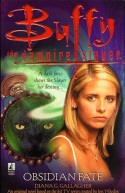 In 1520, a Spaniard conveying stolen Aztec treasure to a secret hiding place was killed by a mudslide while holding a particular obsidian mirror. Now, his remains have been found in an archaeological dig in Sunnydale. It turns out that the mirror contains the essence of the Aztec god of night, Tezcatlipoca, who quickly makes a graduate student working on the dig his High Priestess and adopts a jaguar form to prowl around and do some chomps. The gang must prevent his brainwashed followers from offering enough human sacrifices to empower Tezcatlipoca to banish the sun forever.
In 1520, a Spaniard conveying stolen Aztec treasure to a secret hiding place was killed by a mudslide while holding a particular obsidian mirror. Now, his remains have been found in an archaeological dig in Sunnydale. It turns out that the mirror contains the essence of the Aztec god of night, Tezcatlipoca, who quickly makes a graduate student working on the dig his High Priestess and adopts a jaguar form to prowl around and do some chomps. The gang must prevent his brainwashed followers from offering enough human sacrifices to empower Tezcatlipoca to banish the sun forever.
There were definitely things I liked about Obsidian Fate. I liked that Buffy is worrying about her friends leaving for distant universities and colleges and trying to figure out what she herself is going to do. I liked that Angel has begun to think about moving away to let Buffy live her life. I liked that Giles is still grieving Jenny. A lot of the characterization and dialogue was good—especially Oz, which is pretty difficult to do. Surprisingly, Kendra and Faith both get a mention, though the latter is nowhere to be seen (and this is all set before she goes bad). No Wesley at all. It’s also really neat that the Mayor and Mr. Trick are facilitating Tezcatlipoca’s rise!
But oh man, so many descriptions of temples and stones and boulders and pillars. It’s very tedious. Also, one of their fellow students has become temporary host to part of Tezcatlipoca’s essence and plans to sexually assault Willow prior to sacrificing her. Nobody, besides Oz, seems to be quite as pissed off about this as they should be. Lastly, a subplot about how one of Buffy’s prophetic dreams showed Angel’s demise offers zero suspense. Still, their reunion on the final page does produce a genuinely cute moment.
Is this one worth a read? Eh, it could be worse.
Power of Persuasion by Elizabeth Massie
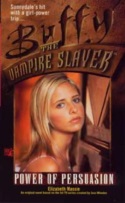 This was a bit of a clunker, I’m afraid. The awkward teen daughter of a culinarily disinclined restaurant owner grows fed up with catering to her incompetent father’s whims and, by chanting supplications whilst surrounded by random items from the restaurant’s pantry, somehow successfully summons a Greek goddess and her two muse daughters to help her change things. They proceed to compel a lot of female students (including Willow) to join their “womyn power” crusade, which mostly involves campaigning for girls to have the right to try out for the vacancies on boys’ teams that arise when male athletes keep turning up dead.
This was a bit of a clunker, I’m afraid. The awkward teen daughter of a culinarily disinclined restaurant owner grows fed up with catering to her incompetent father’s whims and, by chanting supplications whilst surrounded by random items from the restaurant’s pantry, somehow successfully summons a Greek goddess and her two muse daughters to help her change things. They proceed to compel a lot of female students (including Willow) to join their “womyn power” crusade, which mostly involves campaigning for girls to have the right to try out for the vacancies on boys’ teams that arise when male athletes keep turning up dead.
Many of these Buffy media tie-in novels have similarly mediocre plots, but are usually made more tolerable by the author having the ability to capture how characters speak and interact. Not so much here, unfortunately. I appreciated that with Willow, Giles, and Xander falling under the sway of the villains and Angel out of town, Buffy had to rely on Cordelia and Oz to help her. But, while Cordelia’s scenes were fine, much of Oz’s dialogue and demeanor seemed wrong to me. Also, some weird abilities are ascribed to vampires, like one scene where a struggling vamp leaves scorch marks where her heels have dug into the earth.
I suppose the best praise I can muster is, “It’s pretty lame, but at least it’s short.”
Prime Evil by Diana G. Gallagher
 Seldom have I read a book so starkly divided between enjoyable parts and excruciating parts!
Seldom have I read a book so starkly divided between enjoyable parts and excruciating parts!
Set after “Doppelgangland,” the plot of Prime Evil involves a witch attuned to “primal magick” who was first born 19,000 years ago and who keeps being reincarnated and gathering sacrificial followers in an attempt to access “the source.” Her current identity is Crystal Gordon, a new history teacher at Sunnydale High, and her latest crop of doomed devotees is composed entirely of students. Obviously, it’s the Scooby Gang’s job to stop her.
First, the good. Most of the scenes with the main characters are fun, with dialogue that I could easily hear in the actors’ voices. Anya and Joyce have significant roles, and there was notable awkwardness between the latter and Giles. Although this was presumably the result of their dalliance in “Band Candy,” I liked that the explanation wasn’t explicitly stated. I thought it was interesting that Crystal tempts Willow to join her disciples by promising a cure for Oz, and I did have to snicker at a scene in which Angel, for the sake of expedience in getting to safety, has to sling Xander over his shoulder.
The bad, however, cannot be denied. There are many tedious flashbacks to Crystal’s past incarnations and these quickly became literally groan-inducing. In addition, the theoretically climactic magical battle at the end is full of prose like “The great source-river of wild magick coursed in violent abandon through the orbits of comets so ancient and distant they had never been warmed by the sun” and succeeded only in making me profoundly sleepy.
In summation… zzz.
Resurrecting Ravana by Ray Garton
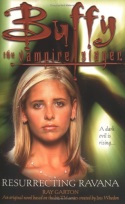 A rash of cattle mutilations has the Scooby Gang suspecting hellhound activity, but when several people turn up eaten, after each has spontaneously killed their dearest friend, it’s clear something else is up. There’s more of a mystery here than these books generally offer, with a plot that features Hindu gods, an elderly collector of magical artifacts, his lonely granddaughter, and a certain statue that can resurrect a deity who will reward one richly for this service (and whose minions will kill everyone else).
A rash of cattle mutilations has the Scooby Gang suspecting hellhound activity, but when several people turn up eaten, after each has spontaneously killed their dearest friend, it’s clear something else is up. There’s more of a mystery here than these books generally offer, with a plot that features Hindu gods, an elderly collector of magical artifacts, his lonely granddaughter, and a certain statue that can resurrect a deity who will reward one richly for this service (and whose minions will kill everyone else).
Along the way, a new guidance counselor of Indian descent is introduced (replacing the guy who got killed in “Beauty and the Beasts”). At first, I thought this was going to be another one of those “Willow falls under the sway of a new female staff/faculty member who is secretly evil” storylines, but, refreshingly, that did not turn out to be the case. Willow just talks to her about problems with her relationship with Buffy, which come to a head in a couple of full-on brawls in the library. It takes a really long time for anyone to put together that their situation parallels the murders/devourings happening elsewhere in town, but it does lead to a nice final moment for the book.
Characterization is spotty. Pretty much each character has a moment that feels especially right as well as one that feels especially wrong. Xander and Cordelia’s bickering is even nastier than usual, and it’s never outright said that they’re being affected by the same creatures who manipulated Buffy and Willow. That said, I did enjoy all of Buffy’s interactions with her mother, particularly a late-night trip to Denny’s. All in all, Resurrecting Ravana wasn’t bad!
Return to Chaos by Craig Shaw Gardner
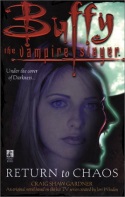 Return to Chaos is a bit different from most of the other Buffy tie-in books I’ve read. Instead of a new big villain coming to town, the plot is mostly about some new allies coming to town. A quartet of Druids, specifically, consisting of an older guy named George and his three nephews, one of whom develops feelings for Buffy. George wants to enlists the Slayer’s help in performing a spell on the Hellmouth that will supposedly prevent bad things from crossing over, but he’s really vague about his plans, and it soon becomes evident that he isn’t in his right mind. The nephews genuinely are allies, though, which is kind of refreshing.
Return to Chaos is a bit different from most of the other Buffy tie-in books I’ve read. Instead of a new big villain coming to town, the plot is mostly about some new allies coming to town. A quartet of Druids, specifically, consisting of an older guy named George and his three nephews, one of whom develops feelings for Buffy. George wants to enlists the Slayer’s help in performing a spell on the Hellmouth that will supposedly prevent bad things from crossing over, but he’s really vague about his plans, and it soon becomes evident that he isn’t in his right mind. The nephews genuinely are allies, though, which is kind of refreshing.
This book was written in 1998, and it seems that the author was not privy to much that was going to happen in season three. A couple of vague references are made to Angel coming back, and about Buffy trying to move on romantically, but Xander and Cordelia are still very much together as a couple. That would put this somewhere between “Beauty and the Beasts” (episode four) and “Lover’s Walk” (episode eight), except that it is very clearly spring and we know that “Amends” (episode ten) is Christmas. Oopsies. There are a couple of other small errors, too, concerning Buffy’s eye color and Giles’ glasses.
This is another book in which there’s more of Oz than I’d been expecting. Some of his scenes and thoughts are okay, and I appreciated that the author wrote a teensy bit about Oz’s family, but at other times he just seems far too verbose. (This, combined with the errors mentioned above, makes me wonder just how familiar the author was with these characters.) Cordelia has a subplot of her own, as well, in which she falls under the thrall of a former rival turned vampire. The Druids recognize that the vampire is using a “mastery” spell, which is likened to the power Drusilla exhibited when she was able to kill Kendra so easily. I thought that was kind of neat.
In the end, despite some flaws, it turned out to be pretty decent.
Revenant by Mel Odom
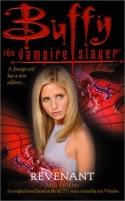 In 1853, 35 Chinese laborers were killed in a mine cave-in on a site owned by some of Sunnydale’s forefathers. The incident was covered up and families were unable to provide their loved ones with a proper burial. Now, the unquiet spirits of those men want vengeance on the owners’ descendants and have managed to communicate with the troubled brother of one of Willow’s friends, who enlists her help. Honestly, this plot doesn’t make a whole lot of sense, but there’s a rich importer involved (who’s receiving help from the mayor) and chanting and statues and dragons and warehouses what go boom and demons that turn into goop.
In 1853, 35 Chinese laborers were killed in a mine cave-in on a site owned by some of Sunnydale’s forefathers. The incident was covered up and families were unable to provide their loved ones with a proper burial. Now, the unquiet spirits of those men want vengeance on the owners’ descendants and have managed to communicate with the troubled brother of one of Willow’s friends, who enlists her help. Honestly, this plot doesn’t make a whole lot of sense, but there’s a rich importer involved (who’s receiving help from the mayor) and chanting and statues and dragons and warehouses what go boom and demons that turn into goop.
Sometimes, Odom has a bit of trouble with characterization—Oz’s dialogue often doesn’t feel quite right, and sometimes Buffy comes off as vapid, like an early scene where she’s worried about her hair while Willow is running for her life—but other scenes are spot-on. I particularly liked a moment where Giles is forced to hotwire a truck (“I was not always a good boy”) and the final scene wherein Xander attempts to parlay his latest romantic disappointment into Buffy’s half of a Twinkie they’re sharing. Odom also incorporates and elaborates on some of the issues characters are worrying about at this point in the show: Buffy ponders her future with Angel, Xander dreads being left behind after graduation, and Cordelia seeks to avoid trouble at home by helping with research. The action scenes are easy to envision, as well.
Unlike most other books set during this season, the brief Xander/Willow fling and its fallout are acknowledged. Like the others, neither Faith nor Wesley is mentioned, and the former’s absence is particularly glaring, given the evident difficulty of the big battle. Still, Revenant ended up being a pleasant surprise.


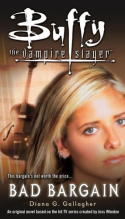

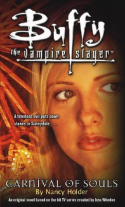
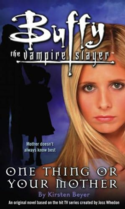
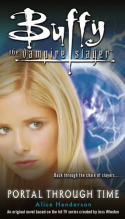



Recent Comments